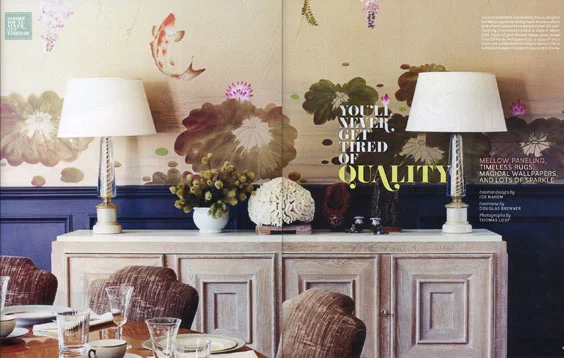House Beautiful Oct '09, "You'll Never Get Tired of Quality"
pages 98-105 by Douglas Brenner
YOU’LL NEVER GET TIRED OF QUALITY – MELLOW PANELING, TIMELESS RUGS, MAGICAL WALLPAPERS, AND LOTS OF SPARKLE
DOUGLAS BRENNER: Even the spiffiest new spec houses can feel raw and generic. This one is anything but. How long did it take you to give it so much patina and personality?
JOE NAHEM: About four months. The owners said, ‘We absolutely need to move in time for the kids to start school.’ There were three children, plus four or five dogs, several cats, birds, a bunch of fish. A complex household. Luckily, they were decisive. They wanted it to be traditional, but still young and fresh. Fabrics had to be durable enough not to feel hands-off-or paws-off-for kids and pets. They wanted a dining room that wasn’t Thanksgiving-Christmas-only, and a laid-back family room where everybody could hang out. The rooms had nice proportions, but they were really big and needed cozying up-and that was going to be our job. Buying some vintage furniture and rugs helped take off the new-house edge. And layers of point, wallcoverings, and hand-plastering gave the Sheetrock richness and depth
DOUGLAS BRENNER: Did anybody get cold feet about that aquatic wallcovering in the dining room?
JOE NAHEM: It was an easy sell. The owners have a koi pond right outside the window. When we saw the pattern of that wallcovering, which is so beautiful, we thought it would be perfect. We knew that, after all this time-they’ve had some of those koi for 15 years- they’d never get bored with the pattern and say, ‘OK, enough of the fish. We’ve got parakeets now.’
DOUGLAS BRENNER: Why did you paint the wainscoting and trim such a dark color?
JOE NAHEM: the room is so big and gets so much light, we thought it would make it feel a little cozier-and would help with that wallcovering. It has a lot of depth but also a lot of luminescence because of the silk stitching on top of the hand-painted paper. It makes every one of those fish, every flower petal shimmer. And that huge Venetian chandelier has a glow that’s like looking through a glass of Champagne-especially after you’ve had a few glasses yourself. It goes with those Queen Anne-ish chairs that are sort of Syrie Maugham by way of Samuel Marx. I think those chairs have a sense of humor. Their shape has a great twist that takes some of the rigidity out of the room.
DOUGLAS BRENNER: Is a sense of humor important in decorating?
JOE NAHEM: It’s especially important in grandiose spec houses like this that developers call manors or chateaux. We’re, ‘OK, let’s take this back to reality. People are walking around here in their slippers and eating popcorn and watching TV like everybody else.’ So it’s good to play around with things a bit and not take things so seriously. When you get some original forties chair, it doesn’t have to be like, ‘Well, they probably had some silk satin on it, so we will, too.’ I might cover it in linen or giant embroidery, to lighten it up.
DOUGLAS BRENNER: Still, you’ve used lots of seriously fine 1940s French and Italian furniture. Is that era a favorite of yours?
JOE NAHEM: I got turned on to it back in the early nineties by another client who insisted I try something different. The variety amazed me-gutsy, heavy pieces as well as finely detailed ones, and fascinating shapes and architectural proportions.
DOUGLAS BRENNER: Did putting those two giant sofas together in the living room feel like a risky move?
JOE NAHEM: It takes a certain kind of room to pull that off-something I’ve been trying to do for a long time, thought it never seemed to work. But it was perfect in here because this is a very big room, and we were trying to make it a little more intimate, so that three or five people could sit in there without feeling lost. At the same time, if you’re entertaining 15 or 20, there’s enough room for everybody to break up and move around the room and also look out toward the pond or back toward the fireplace. The owners appreciate how special those sofas are. It’s nice when you have clients who are eager to learn, and who understand what they’re paying for-the hand-sprung edges of a sofa, hand-tied springs, down with horsehair on top. I’m a bit of a fanatic about upholstery. I’ve had clients show me sofas that they’ve had for 30 years-they’re in amazing shape and still look great. Craftsmanship and comfort don’t date.
DOUGLAS BRENNER: What gives an interior lasting appeal?
JOE NAHEM: I hate the word ‘eclectic’ because it usually means somebody’s just grabbing stuff without a sense of what really goes with what. But combine periods in a good way, in a delicate way, so that it doesn’t take on the look of any specific era. Nobody’s going to say in five years, ‘This room is so 2009.’ I tell people, ‘We’ll cover one chair in something that’s a little trendy, but in five years, you can just change it. It’s not like you have to rip out bathroom tile.’
DOUGLAS BRENNER: Has any lesson you learned early in your career stuck with you?
JOE NAHEM: I learned never to say never, in any context-like, I’ll never eat that, I would never wear that. Because I surprise myself when I open up to things. If you’d asked me 15 years ago if I’d be putting a 1600’s embossed-leather folding screen together with an embroidered settee and an Oriental rug, as I did in the living room, I would have said, ‘No way.’ But they totally deliver.




